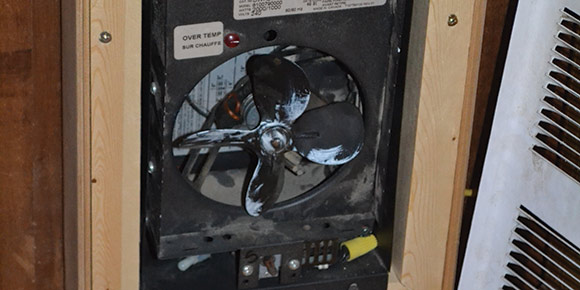I used to freeze my derriere in my office until I discovered an easy-to-install electric space heater with a built in fan and thermostat.
Prior to my aha moment, I attempted to warm up my office with a six-foot long, baseboard heater rated at 2000 watts. Whenever this power sucker was turned on, the wheel on my hydro meter would spin like the Tasmanian Devil of Looney Tunes notoriety.
I am not suggesting that I expect a free lunch when it comes to heating a room in winter. However, at the same time, I do not expect to pay for a Hydro buffet in return for an inefficient device that operates by convection current only.
The forced air heater I replaced my baseboard unit with is a Dimplex 240-volt model with a variable 1500 to 2000 watt output; it can be mounted between wall studs or directly onto a wall.
As I did not want to cut a hole into the finished wall in my office, I decided to build a pine cabinet to house my heater instead.
The outside dimensions of the heater are 8-inches by 16-inches by 1½-inches deep. The instructions say to leave a 2-inch gap between all sides of the unit and the cabinet, so the full size of my cabinet is 11 ½-inches by 19 ½-inches, allowing for the ¾-inch thickness of the pine.
I gussied up the box with mitered corners and by rounding the outside pine edges with a ½-inch carbide bit in my router. I used small wood cleats glued and screwed to the top and bottom of the cabinet’s interior to mount the unit to the wall with screws.
I placed my cabinet low to the floor (heat rises) and about five feet from my chair and desk, an optimum distance for the fan-forced heat to spread and rise, bathing me in warm air.
I installed the heater inside the cabinet using screws provided by the manufacturer.
I drilled a ½-inch hole into one side of the cabinet to receive the wiring to connect the heater coil and fan.
Hard-wired 240-volt heating devices (not plugged into wall outlets) require a double pole 120-volt circuit breaker to be installed in your home’s breaker box. If you do not feel confident about completing this step on your own, call an electrician.
I was fortunate because the required breaker and most of the wiring from the main box was already in place because of my existing baseboard heater.
Depending on the distance from the main electrical box to a 240-volt heater that consumes about 8.5 amps at full power, the size of the wire that carries the load must be considered. For a run of, say, 40 feet or more, 12/2 NM cable (copper) is recommended; for shorter runs, 14/2 NM is acceptable. More expensive metallic-sheathed cable may be required in areas where NM wire cannot be protected from mechanical damage by being fished through walls or otherwise enclosed.
You do not need 12/3 or 14/3 wire to hook up a 240-volt heater, unless you require an extra “hot” wire for some other purpose.
I purchased a simple Dimplex line voltage thermostat for about $23 for the convenience of having a wall mounted control. Using easy to understand instructions included with the thermostat, I connected it to the heater, overriding its built in thermostat. This change required more wiring on my part, but was worth it for the luxury of not having to bend over to adjust my newly installed forced-air heater.
For single rooms, bathrooms and entranceways, these compact, efficient units will return every penny of sweat equity you put into them.
davidsquare81@yahoo.com



